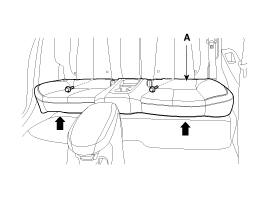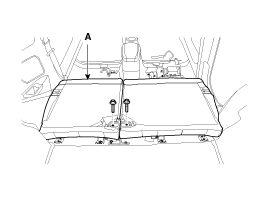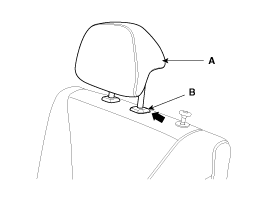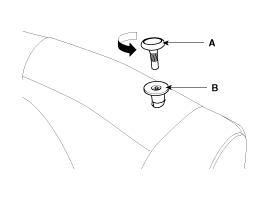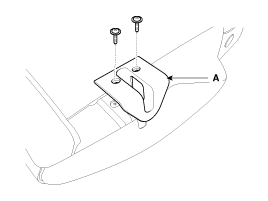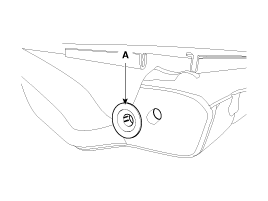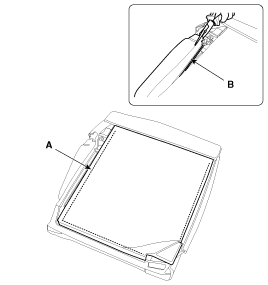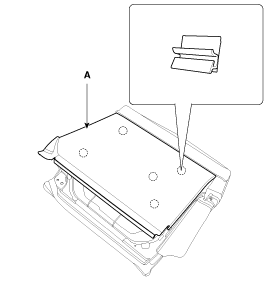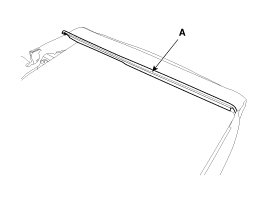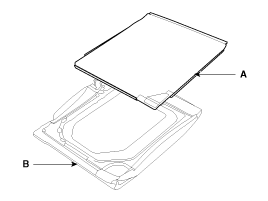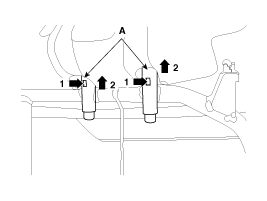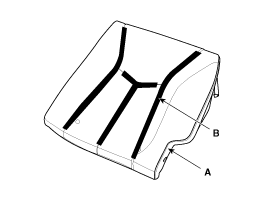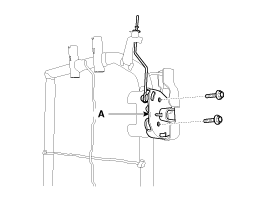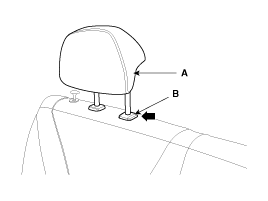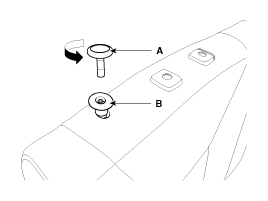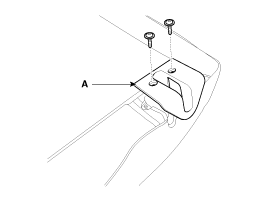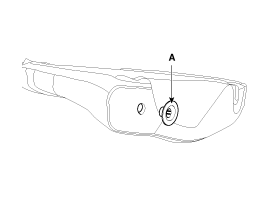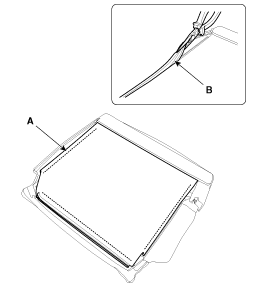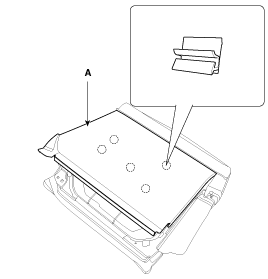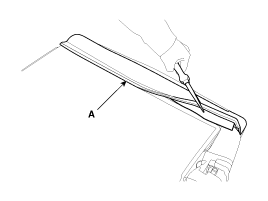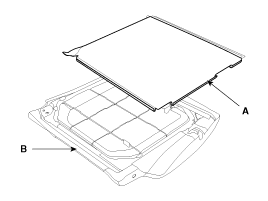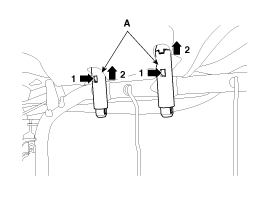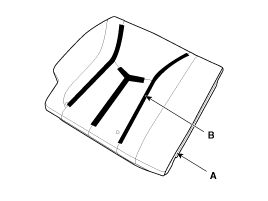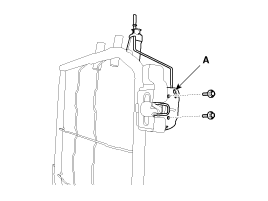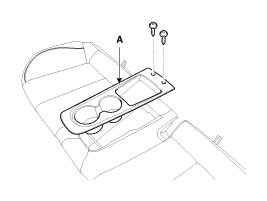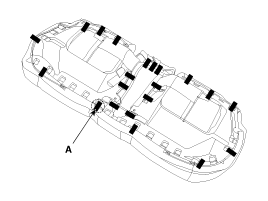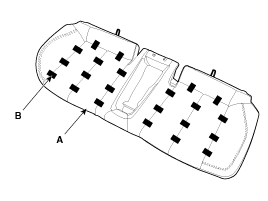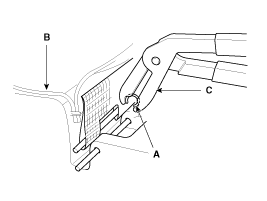 Hyundai Veloster: Rear Seat. Repair procedures
Hyundai Veloster 2011-2017 Service Manual / Body (Interior and Exterior) / Seat & Power Seat / Rear Seat. Repair procedures
Hyundai Veloster: Rear Seat. Repair procedures
Hyundai Veloster 2011-2017 Service Manual / Body (Interior and Exterior) / Seat & Power Seat / Rear Seat. Repair procedures
Replacement
| 1. |
After loosening the mounting bolts, then remove the
rear seat cushion (A).
|
| 2. |
After loosening the mounting bolts, then remove the
rear seat back (A).
|
| 3. |
Installation is the reverse of removal.
|
|
| 1. |
Remove rear seat back assembly.
|
| 2. |
Push the lock pin (B), remove the headrest (A).
|
| 3. |
Remove the rear seat folding lever (A) after turning
in the counter clock-wise direction.
|
| 4. |
Remove the rear seat folding lever cover (B).
|
| 5. |
After loosening the mounting screws, then remove
the rear seat latch cover (A).
|
| 6. |
Using a screwdriver or remover, remove the rear seat
side bracket cover (A).
|
| 7. |
Push the protecter (B) by the rear seat back panel
(A).
|
| 8. |
Using a screwdriver or remover, remove the rear seat
back panel (A).
|
| 9. |
Disconnect the protector (A).
|
| 10. |
Remove the rear seat back panel (A) from the rear
seat back frame (B).
|
| 11. |
Pull out the headrest guides (A) while pinching the
end of the guides, and remove them.
|
| 12. |
Remove the rear seat back cover from the rear seat
back frame.
|
| 13. |
After removing the velcro tape (B) on the rear of
seat back and remove the seat back cover (A).
|
| 14. |
Installation is the reverse of removal.
|
|
| 1. |
Remove the following items first.
|
| 2. |
After loosening the mounting bolts, then remove the
rear seat latch assembly (A).
|
| 3. |
Installation is the reverse of removal.
|
|
| 1. |
Remove rear seat back assembly.
|
| 2. |
Push the lock pin (B), remove the headrest (A).
|
| 3. |
Remove the rear seat folding lever (A) after turning
in the counter clock-wise direction.
|
| 4. |
Remove the rear seat folding lever cover (B).
|
| 5. |
After loosening the mounting screws, then remove
the rear seat latch cover (A).
|
| 6. |
Using a screwdriver or remover, remove the rear seat
side bracket cover (A).
|
| 7. |
Push the protecter (B) by the rear seat back panel
(A).
|
| 8. |
Using a screwdriver or remover, remove the rear seat
back panel (A).
|
| 9. |
Disconnect the protector (A).
|
| 10. |
Remove the rear seat back panel (A) from the rear
seat back frame (B).
|
| 11. |
Pull out the headrest guides (A) while pinching the
end of the guides, and remove them.
|
| 12. |
Remove the rear seat back cover from the rear seat
back frame.
|
| 13. |
After removing the velcro tape (B) on the rear of
seat back and remove the seat back cover (A).
|
| 14. |
Installation is the reverse of removal.
|
|
| 1. |
Remove the following items first.
|
| 2. |
After loosening the mounting bolts, then remove the
rear seat latch assembly (A).
|
| 3. |
Installation is the reverse of removal.
|
|
| 1. |
Remove the following items first.
|
| 2. |
After loosening the mounting screws, then remove
the rear seat cup holder panel assembly (A).
|
| 3. |
Remove the mounting clips (A).
|
| 4. |
After removing the hog-ring clips (B) on the rear
of seat cushion and remove the seat cushion cover (A).
|
| 5. |
Installation is the reverse of removal.
|
 Rear Seat. Components and
Components Location
Rear Seat. Components and
Components Location
Components
1. Headrest [RH]
2. Headrest guide [RH]
3. Rear seat back cover [RH]
4. Rear seat cushion cover [RH]
5. Cup holder panel assembly
6. Headrest [LH]
7. H ...
 Seat Belt
Seat Belt
...
See also:
Good driving practices
Never move the gear shift lever from P (Park) or N (Neutral) to any other
position with the accelerator pedal depressed.
Never move the gear shift lever into P (Park) when the vehicle is in mo ...
Input Speed Sensor 1 > Description and Operation
Description
The input shaft speed sensor is important in that it detects the input
shaft RPM and sends this information to the TCM. It provides important input
information for electric contr ...
Vehicle stability management (VSM)
This system provides further enhancements to vehicle stability and steering responses
when a vehicle is driving on a slippery road or a vehicle detected changes in coefficient
of friction between ...
Categories
- Hyundai Veloster Manuals Home
- Hyundai Veloster 2010-2017 Owner's Manual
- Hyundai Veloster 2010-2017 Service Manual

